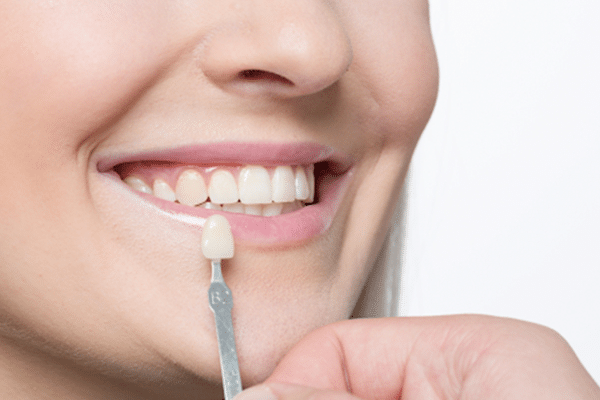Dental crowns and veneers are dental restorations used by dentists to improve the look and function of patients’ teeth. Such restorations help correct damage, decay and/or imperfections, and protect teeth against further damage or wear.
Modern crowns and veneers are made from materials that closely resemble natural teeth, making it hard for others to detect that you have had such dental procedures done. Perhaps the most popular option these days is dental porcelain which, when formed into crowns or veneers, is similar to healthy natural teeth in colour, texture and hardness.
If you have concerns about the appearance of your teeth, such as serious discolouration, gaps between teeth, unevenness, cracked, chipped or worn down teeth, your dentist would be able to advise you on the best course of action, which often involves crowns and/or veneers.
While these two types of prostheses share plenty of common ground, they are different. Knowing what makes them different can empower you to make an informed decision whether either is suitable for you.
What are crowns?
We are all born with crowns – the crowns of our teeth, that is. The ‘crown’ is the hard, visible, part of the tooth above our gums over the root structures. Natural crowns are covered with an outer translucent white, crystallised layer known as enamel. It is hard and protective in function. Dental crowns are artificial replacements for this part of the tooth and are made from a variety of materials that can be safely bonded to the core of the tooth to perform the tooth’s functions. The procedure for crowning is performed over 2 or more (but usually 2) visits:
During the first visit your dentist will prepare the tooth by shaving it down, removing most of the enamel layer and leaving the core, which contains the dentine, and pulp (consisting of nerves, and blood vessels). They will then take a mould of the reduced tooth and send that to a dental laboratory, where your new crown is fabricated.
On your second visit, the dentist will fit the new crown on top of the tooth and bond it in place with dental cement. You walk out of the clinic with a brand new outer tooth – besides the fact that any pre-existing damage or decay is eliminated, shape, colour and alignment can all be improved. Think of it as a facelift for your tooth.
Digital innovations such as CEREC allow crowns to be made without the conventional mould (impression). A small digital scanner is used to take images of the prepared tooth and these are transmitted to a computer, where a crown is designed. A ceramic restoration can be milled in a single visit, saving the patient the need for a second appointment or a temporary crown. Your dentist would be the best person to advise you on your suitability for a CEREC ceramic crown
What are veneers and how are they different from crowns?
Veneers are almost like partial crowns and generally used to cover the front surface of teeth that are exposed when you smile. As its name suggests, a veneer is a layer of material that coats or overlays the outward-facing surfaces of teeth.
Like crowns, they can be made from dental porcelain, fabricated in a lab from a mould, and bonded to teeth with dental cement. However, they do not cover the entire tooth, only the outer surface, and are thus most often used for purely cosmetic reasons as the physical protection offered by a veneer is minimal.
A popular alternative procedure is to apply a viscous composite resin material directly onto the target surface, without need for mould-taking or laboratory fabrication. This is known as direct resin veneer. It is suitable when minimal aesthetic modifications are needed. Little or even no preparation (shaving down of the tooth) is needed. This is an important consideration, as I will elaborate on later.
So what do I need to consider?
The first and most important rule is always to heed your dentist’s advice.
After examining the state of your teeth, including the parts that you or others can’t see, he or she will be able to make a professional recommendation aimed at prolonging your dental health and function for the longest possible time.
Crowns, for instance, have a protective function as equally important as their cosmetic value and are often the only option to restore severely damaged teeth, teeth with root canal treatment, and heavily filled or cracked teeth with the possibility of further breakage, decay or infection.
If your teeth are otherwise healthy, opting for crowns comes at a considerable cost: the preparation process necessary to allow a new crown to fit over the tooth destroys a large amount of natural, healthy tooth structure. It also carries the risk of complications (such as pulpal infection) and side effects (such as sensitivity).
In general, if cosmetic appearance is your only concern, veneers would generally be recommended over crowns. The main advantage here is that much less or no preparation is needed, preserving the natural, healthy state of your teeth. However, not every patient is suitable for veneers. Most of the decision lies strongly on proper examination of your bite (occlusion), health of your dentition and the presence of any parafunction such as nocturnal bruxism (grinding or clenching of your teeth when you sleep).
Our dentists are well-versed with the application of both crowns and veneers. Talk to us for advice on your concerns.
| CROWNS | VENEERS | |
| Higher | Invasiveness | Lower |
| Similar | Cost | Similar |
| Higher | Risk of complications | Lower |
| Higher | Protective function | Lower |
| Higher | Durability | Lower |




